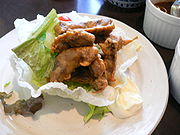
Gyutan
Encyclopedia

Japanese cuisine
Japanese cuisine has developed over the centuries as a result of many political and social changes throughout Japan. The cuisine eventually changed with the advent of the Medieval age which ushered in a shedding of elitism with the age of shogun rule...
that is made from grilled beef tongue. The word gyūtan is a combination of the Japanese
Japanese language
is a language spoken by over 130 million people in Japan and in Japanese emigrant communities. It is a member of the Japonic language family, which has a number of proposed relationships with other languages, none of which has gained wide acceptance among historical linguists .Japanese is an...
word for and the English word tongue. Since gyūtan literally means "cow tongue," the word is also used to refer to cow tongues in Japan
Japan
Japan is an island nation in East Asia. Located in the Pacific Ocean, it lies to the east of the Sea of Japan, China, North Korea, South Korea and Russia, stretching from the Sea of Okhotsk in the north to the East China Sea and Taiwan in the south...
. The custom of cooking gyūtan originated in Sendai
Sendai, Miyagi
is the capital city of Miyagi Prefecture, Japan, and the largest city in the Tōhoku Region. In 2005, the city had a population of one million, and was one of Japan's 19 designated cities...
in 1948, and is usually served with barley rice, tail soup, and pickles in the Sendai area. In other areas in Japan, gyūtan is most often served in yakiniku
Yakiniku
Yakiniku , meaning "grilled meat", is a Japanese term which, in its broadest sense, refers to grilled meat dishes. The present style of yakiniku restaurants are derived from the Korean restaurants in Osaka and Tokyo which were opened around 1945....
restaurants. Gyūtan was originally conceived to be flavored with salt
Salt
In chemistry, salts are ionic compounds that result from the neutralization reaction of an acid and a base. They are composed of cations and anions so that the product is electrically neutral...
, which lead to gyūtan being called in many yakiniku restaurants. However, some stores now serve gyūtan with tare sauce
Tare sauce
Tare is a general term in Japanese cuisine for dipping sauces often used in grilling as well as with sushi, nabemono and gyoza. The sauce is best described as sweetened, thickened soy sauce for grilling and flavored soy sauce with dashi, vinegar, etc., for nabemono and natto such as ponzu but...
.
History
Gyūtan was created when Sano Keishirō, the owner of a yakitoriYakitori
, grilled chicken, is commonly a Japanese type of skewered chicken. The term Yakitori can also refer to skewered food in general. Kushiyaki , is a formal term that encompasses both poultry and non-poultry items, skewered and grilled...
restaurant in Sendai, opened a new restaurant that served cow tongue dishes in 1948. This restaurant was called Tasuke (太助), and is still considered one of the best places to eat gyūtan in Sendai. Sano decided to open this restaurant to use cow tongues and tails left over by occupation
Occupied Japan
At the end of World War II, Japan was occupied by the Allied Powers, led by the United States with contributions also from Australia, India, New Zealand and the United Kingdom. This foreign presence marked the first time in its history that the island nation had been occupied by a foreign power...
forces, which were stationed in Sendai after Japan was defeated in World War II
World War II
World War II, or the Second World War , was a global conflict lasting from 1939 to 1945, involving most of the world's nations—including all of the great powers—eventually forming two opposing military alliances: the Allies and the Axis...
. Gyūtan was initially considered a rather unusual dish, but gradually gained popularity throughout Japan, partially because white collar workers
Salaryman
refers to someone whose income is salary based; particularly those working for corporations. Its frequent use by Japanese corporations, and its prevalence in Japanese manga and anime has gradually led to its acceptance in English-speaking countries as a noun for a Japanese white-collar...
who were transferred from Sendai spread its reputation to other cities.
Gyūtan restaurants received a boost in 1991, when Japan's import quota
Import quota
An import quota is a type of protectionist trade restriction that sets a physical limit on the quantity of a good that can be imported into a country in a given period of time....
s for beef were eliminated. In 2003, the Japanese government temporarily banned American
United States
The United States of America is a federal constitutional republic comprising fifty states and a federal district...
beef imports after the mad cow disease
Bovine spongiform encephalopathy
Bovine spongiform encephalopathy , commonly known as mad-cow disease, is a fatal neurodegenerative disease in cattle that causes a spongy degeneration in the brain and spinal cord. BSE has a long incubation period, about 30 months to 8 years, usually affecting adult cattle at a peak age onset of...
was discovered in the country. This was a devastating blow for many gyūtan restaurants. For example, 90% of the beef tongues used in gyūtan restaurants in Sendai were imported from the U.S. Additionally, some connoisseurs claim that U.S. beef contains the ideal amount of fat for gyūtan dishes and refuse to use Australia
Australia
Australia , officially the Commonwealth of Australia, is a country in the Southern Hemisphere comprising the mainland of the Australian continent, the island of Tasmania, and numerous smaller islands in the Indian and Pacific Oceans. It is the world's sixth-largest country by total area...
n beef. Since cow tongues may have high amounts of the prion protein that causes mad cow disease, the future of gyūtan is dubious.

